Monograph — Edition 2025
« Dear friends, we are Ödland.
We love winds and violins, clouds and pianos.
We must dream, lest we forget this landscape.
We were born on a runaway train and travel with ghosts.
Our shadow shall be reborn, for the past is our light.
Dear friends, welcome to our lands. »
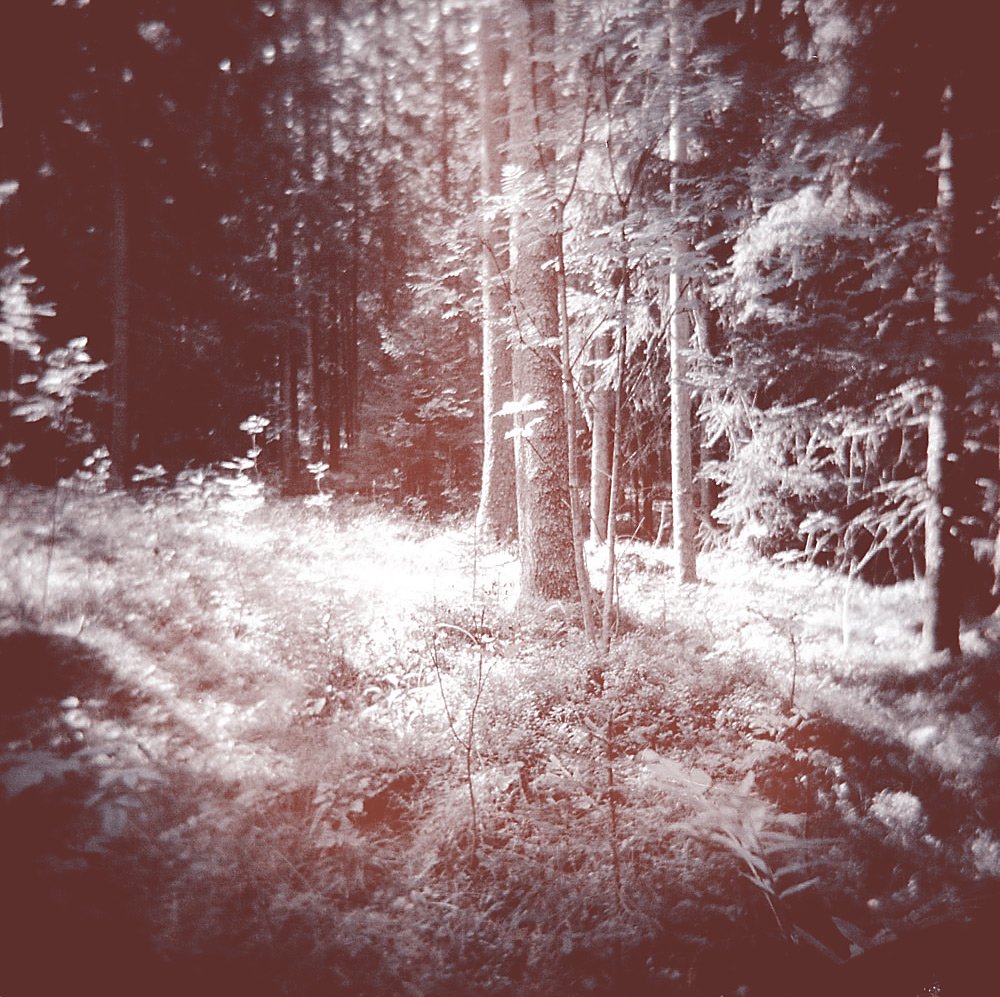
There are countries that do not appear on any map. Ödland is one of them.
Born of a journey, a shared impulse, a common intuition, Ödland has been built as one builds an inner world: through layers, through memories, through signs. From the ruins of forgotten Europe to the distant marshes of Lapland, from twilight shores to invisible stars, every journey, every creation has unveiled a fragment of this secret territory.
This land speaks many tongues.
Sometimes, it sings of winter, in the fragile glow of a Sankta Lucia.
Sometimes, it loses itself in the cosmic expanses of a Comet, suspended between nostalgia and the vertigo of wonder.
At other times, it sets sail aboard a White Boat, drifting at the border between memory and dream.
Thus, Ödland weaves a strange geography, made of folklore and uncertain futures, of simple stories and forgotten labyrinths. It is a space where music, images, objects, and texts entwine into a narrative vaster than any one of us.There are invisible lines.
They bind a child’s handmade hat to an ancient Nordic tradition.
They link Athens to Istanbul, Buzludzha to Sloviansk.
They trace an unbroken thread between the ghosts of vanished cities and the dreams of future landscapes.
To journey with Ödland is not to move toward a fixed destination:
it is to explore a map in perpetual invention,
where paths sometimes fold back upon themselves,
where certain doors lead nowhere familiar,
where an unfamiliar breath seems to precede your steps in the dark woods.
It is to learn to read between the lines,
to listen to what the stones, the winds, the fractured silences whisper.
For our land eludes the eye. And yet — it is there, hidden in the shadows, patient, ready to open its folds to those who are willing to lose themselves within it.
Ödland.
A name of wasteland, of desert, of forgotten country.
In German, Ödland literally means “wasteland” — an abandoned space, suspended between ruin and rebirth. But under the pen of Lorenzo Papace, Alizée and Léa Bingöllü, this word becomes far more than a mere evocation: it names an imaginary territory, at once musical, poetic, and sensorial.
A mysterious refuge, nestled somewhere between the Scandinavian mists, the industrial ruins of Eastern Europe, the haunted forests of European folklore, and the erased memories of childhood.
A country at the margins of reality, reached by boarding rusted trains, following forgotten byways, or listening to the echoes of a memory that refuses to fade.
In this parallel universe, the ghosts of the past still dance, tales whisper in the ears of the living, and songs are woven like fragile paper spells. Since 2008, the group Ödland has been tracing a singular path through the independent musical landscape.
Founded in Lyon by Lorenzo Papace (writer, composer, pianist, filmmaker, scenographer, visual artist), together with Alizée Bingöllü (writer, singer, director, actress) and her sister Léa Bingöllü (violinist, thereminist, and musical saw player), the trio has been shaping a handcrafted body of work at the crossroads of many worlds: acoustic chamber music, metamorphosed European folk, melancholic poetry, and a subtle critique of industrial modernity.
Their music is a journey.
A melodic counter-narrative against the dogmas of speed, progress, and forgetting.
In Ödland’s universe, one speaks to the bird before it vanishes, one sings of deadly trains and solstitial feasts of Saint Lucia, one weeps for doomed comets, and sails on boats destined to sink.
It is a music that laughs, that cries, that remembers, that resists. A music that celebrates impermanence, ghosts, disappearances, and tiny rebirths. A music handcrafted, woven by hand and by heart, far from industrial standards, carried by the fragile beauty of its means and the infinite resonance of its ends.
This document is an attempt to chart this invisible territory. To map its hidden sources and erased paths. To say, in fragments, that the world of Ödland exists — even though no one can truly tell where it begins, nor where it ends.
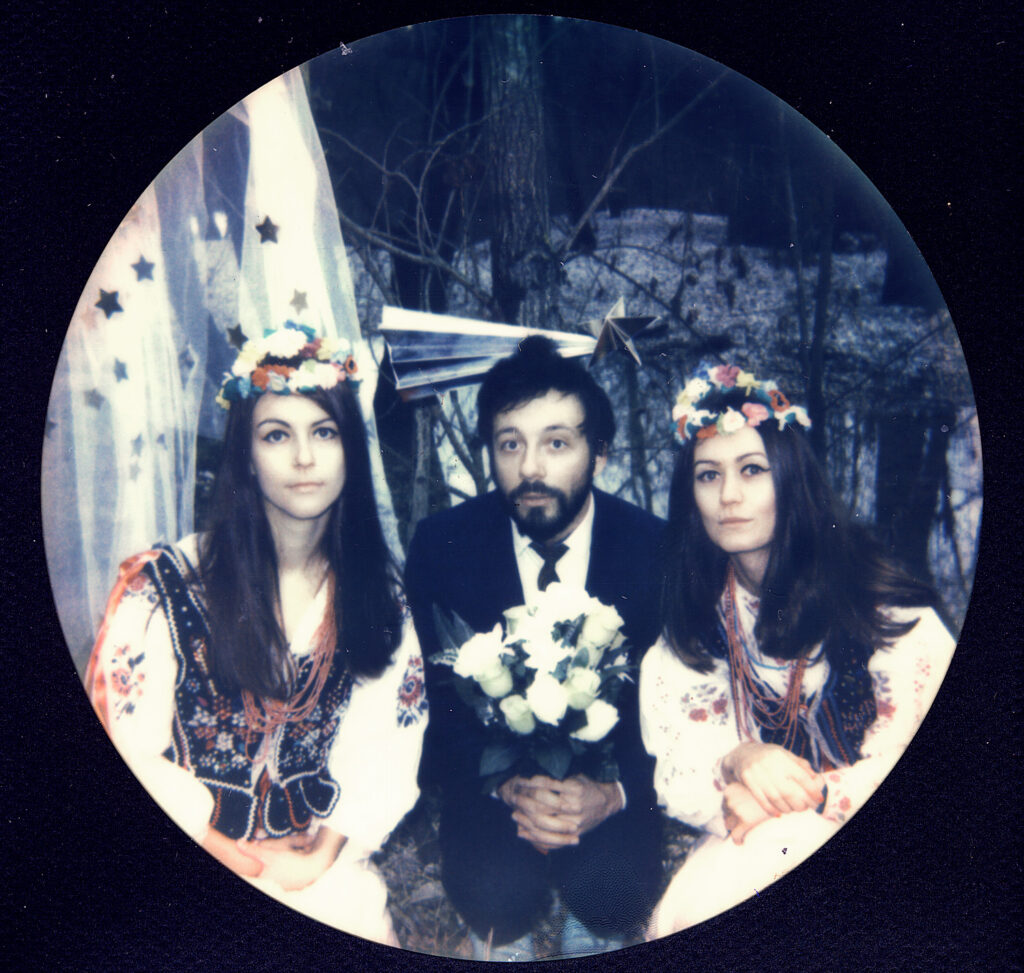
Ödland was born from an artistic and human encounter, far from the beaten paths and traditional mechanisms of the music industry.
At its origin stands Lorenzo Papace — pianist, composer, visual artist — a carrier of a singular vision where music, imagery, and storytelling naturally intertwine. At his side, Alizée Bingöllü — singer, writer, and actress — brings her sensitive timbre, her poetic imagination, and her ability to build bridges between singing and the stage.
Soon after, Alizée’s sister, Léa Bingöllü, joins the adventure, enriching Ödland’s soundscape with her violin, and later with unusual instruments such as the musical saw and the theremin, opening the gates to a spectral, ever-shifting sound.
From the very beginning, Ödland asserted a radical choice: that of absolute independence. No label, no manager, no intermediaries. Each song is composed, arranged, recorded, produced, illustrated, and shared through their own means.
The gesture is artisanal, almost medieval: slowness, care, attention to detail, a love for handcraft and the beauty of imperfection. Their first platform was Myspace, in 2009, followed by their own dedicated website — a direct, heartfelt link to their audience.
In this early blossoming, a fourth figure played a decisive role: the photographer Isabelle Royet-Journoud, known as Féebrile. It was Isabelle who proposed the name Ödland. She also helped shape the band’s original visual imagination: singular costumes, reimagined objects, crepuscular atmospheres.
On stage, she played the ukulele, the tambourine, and animated a multitude of small toy instruments. Present during the first tours and visual projects, she withdrew in 2012, leaving a lasting imprint on Ödland’s aesthetic universe.
From its very first steps, Ödland traced a singular line:
More than just a band, Ödland immediately became a total space of creation, at the crossroads of multiple arts. An expanding inner world. A shadow country, made of sounds, of paper, of gestures, of silences.
Ödland’s logic has never been that of the market or speed: it is that of the direct bond, the manual gesture, the attention to every detail.
Each album, each concert, each visual piece becomes an invitation to step into a fragment of Ödland’s secret territory — as if one were opening a hidden door onto a vanished world.
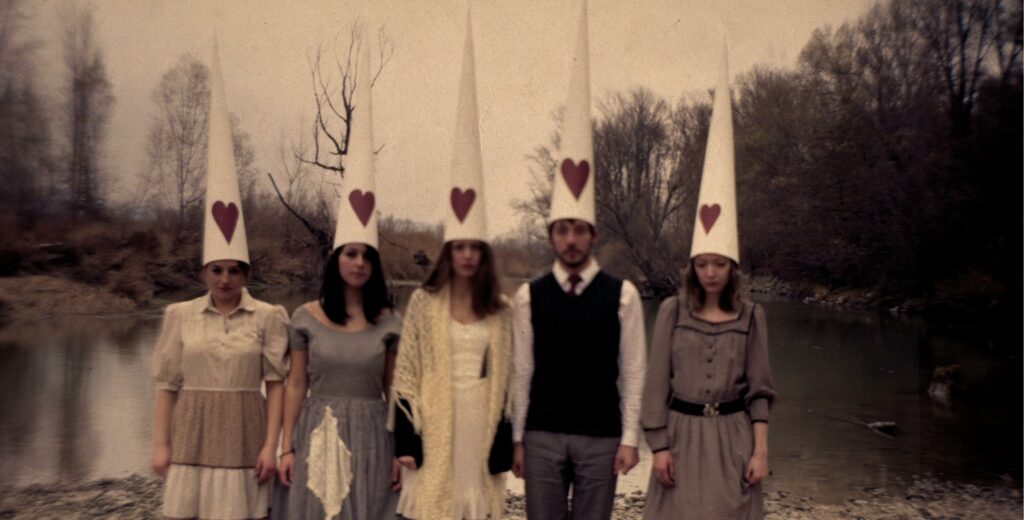
Ödland never contented itself with merely existing: it unfolded, like an inner map slowly unrolled as one ventures forward. Each creation, each journey, each encounter added a new fragment to this shifting territory.
In 2009, the band made its first public breakthrough with The Caterpillar, a fragile, almost whispered, deliberately lo-fi debut EP, entirely self-produced. Recorded in Lyon with modest means, this record already sketched out what would become Ödland’s signature: a meticulous weaving of acoustic music, dreamlike evocations, sonic surprises, and storytelling. The Caterpillar is a blend of love songs and dark, fantastical worlds, tinged with humor.
On May 16th, 2009, aboard a boat in Lyon (La Marquise), Ödland gave its very first concert. A founding image: that of a group embarked upon the currents of a musical adventure.
Then came Ottocento (2010), their first full-length album. With it, Ödland affirmed its ability to construct entire worlds. Each piece is like an artifact in a cabinet of curiosities.
The sonic architecture is highly distinctive, evoking silent films, ancient ballets, and vanished popular festivals. Inspired by 19th-century Europe — Ottocento literally meaning “eight hundred” in Italian, referring to the 1800s — this album is haunted by the melancholy of a bygone era, but never trapped in nostalgia.
Ottocento also carries a discreet lineage with the world of Alice in Wonderland: a fascination for off-kilter realms, absurd logics, and shifts in scale and perspective. A fantastical imagination to which the group paid quiet homage, before moving beyond it to invent its own, more intimate, cosmogony.
Acoustic instruments reign supreme: piano, violin, cello, musical saw, ukulele, tambourines. Electronic sounds are banished. Alizée’s voice — suspended between fragility and intensity — guides the listener through the corridors of a sleeping old continent.
In Les yeux de l’oiseau, Mon capitaine, and Train, Ödland intertwines piano, violin, musical saw, toy instruments, and a form of lucid naivety to evoke flowers growing in the cracks of liminal zones, the mental odysseys of a ship without a harbor, or the descent of a runaway locomotive turned monster.
Train, another emblematic song from that era, stands out as a critical allegory of industrial civilization: The fascination with railway progress becomes a metaphor for a system that crushes bodies, severs nature, defies mountains, and ultimately derails. This dense, hallucinatory monologue critiques the myth of human mastery over technology: The train is no longer a tool serving humanity, but an autonomous, dangerous, uncontrollable entity. A contemporary fear surfaces here — that of an industrial world turned monstrous, indifferent to life.
Their concerts were conceived as musical vigils. On stage, the set was composed of suitcases, lanterns, lace, salvaged objects, and worn-out fabrics. A miniature and nomadic theater came to life, between acoustic magic and ancient dreams.
This first chapter laid the foundations for a free, deeply narrative musical universe — at the crossroads between storytelling and modern ruins. Already, Ödland was inventing a folklore yet to come.
Ödland’s logic has never been that of the market or of haste: it is the logic of direct connection, of handmade gestures, of minute attention to every detail. Each album, each concert, each visual piece becomes an invitation to step into a fragment of Ödland’s secret territory — as if opening a hidden door onto a vanished world.
Tinted with a subtle jazz influence, Ottocento also reveals a taste for controlled improvisation and elegant syncopations. It was no accident that the album’s release was celebrated on April 15, 2010, at an iconic venue: the Hot Club of Lyon.
Supported by a loyal community on the Internet, the success of Ottocento enabled the group to envision its first tour. From 2010 onwards, Ödland traveled across France, the United Kingdom, and Germany, performing in small venues, art galleries, theaters, media libraries, shops, apartments, and alternative spaces. These foundational concerts forged a singular stage aesthetic and wove a precious bond with an international audience that was curious and faithful. A video-documentary from that era, directed by Lorenzo Papace, captures its spirit: Watch here
Each album, each concert, each video directed by Lorenzo Papace became not just a project, but an exploration: a fragment of map added to this nameless country their songs were sketching in the shadows.
Already, strange signs were accompanying their journey: an empty compartment on a phantom train, an industrial ruin humming in the wind, missing names on erased station plaques.
As the voyage unfolded, so did the call for new explorations — always further, toward other eclipsed territories…
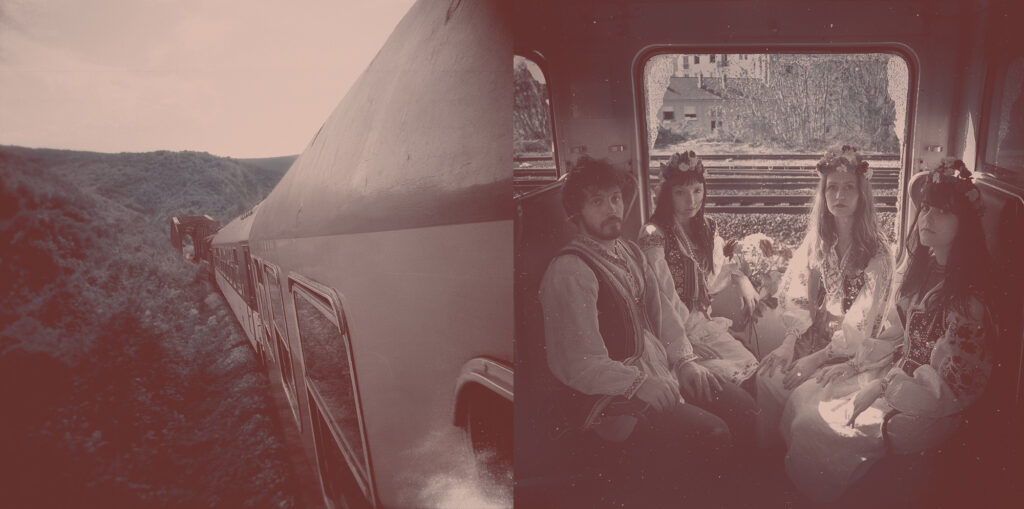
With Sankta Lucia, released in 2011, Ödland continued its musical and poetic quest across a continent painted in chiaroscuro. This concept album was born from a founding gesture: a real journey undertaken across Europe a few months before the composition, to capture the distant echoes of a world fading away.
Armed with a travel journal, a field recorder, and an open attention to chance, Lorenzo roamed Scandinavia, the Balkans, and Central Europe, searching for signs, sounds, stories — grand or humble — and elusive presences. His wanderings traced invisible lines across the continent: lines of memory, lines of flight, lines of fracture.
Upon returning, these collected fragments — images, sounds, sensations — nourished the writing of Sankta Lucia. The Scandinavian festival of Saint Lucia, celebrated on December 13, became their anchor: a fragile light at the heart of winter, a symbol of hope in the darkness.
From this guiding point, the album weaves a fragmented narrative, a sensitive geography of Europe’s folklores, legends, and wounds.
Sankta Lucia is a record of journeys and revenants. Languages intertwine — French, Swedish, English, Italian, Greek, Serbian — as do timelines. Each song becomes a stop along Ödland’s inner map.
Some songs evoke historical episodes or ancient myths (L’enlèvement d’Europe, Trottoirs vermoulus); others take place in trains (Une nuit dans un train serbe, Trains, Thirty-one wanderings). Still others, like La Grèce et moi or Les dieux sont partis, reflect with melancholy on the loss of meaning in a disenchanted world.
The album carries a new political and existential tone. In Trains possibles, the group questions European history and its collapses. The piece begins as a reverie about the 20th century — its utopias, its technological promises — before tipping into gravity: deserted stations, the tracks of Birkenau, the betrayal of progress.
The train, already a metaphor in Ottocento, becomes here the cold instrument of an industrialization that crushes humans and devastates the earth. It is a powerful, sober, almost oracular song that places the group within a tradition of memory and historical responsibility.
Meanwhile, Østersøen, a suspended dream over the Baltic Sea, unfolds another interior geography: A bed floats inside a room, which becomes a train car, which becomes a ship, drifting along the currents. This cascading dream, bordering on the absurd, becomes a metaphor for Europe’s perpetual movement, its geological mutations, its mental drifts.
The stop-motion paper video created by Lorenzo Papace and Vincent Pianina further enhances the fragile poetry of the song, with miniature sets and handmade perspective effects. The film was widely acclaimed for its aesthetic, artisanal, and poetic qualities. Watch here
Musically, Sankta Lucia further expands Ödland’s spectrum. The group explores folk traditions without ever freezing them: traditional chants, liturgical music, and popular laments are transformed into a minimalist acoustic language.
Violin, piano, musical saw, discreet percussion, metallophone, melodica, ukulele, and voice intertwine in chamber textures — a muffled cocoon for often somber narratives, where each silence becomes a precious breath. The aesthetic remains artisanal but gains in breadth and complexity.
The choice to release the album precisely on December 13, the day of Saint Lucia, inscribed the work within a symbolic, almost ritual calendar.
At this time, Ödland intensified its tours across the continent: Lyon, Vienna, Warsaw, Budapest, Šiauliai, Venice, Thessaloniki, Delphi, Ljubljana, Kraków… Each stop became an opportunity to sing, to film, to document. The music videos shot on the very sites of the songs extended the album like poetic pilgrimages.
Through Sankta Lucia, Ödland asserted a unique voice: dreamlike yet well-researched, lyrical yet critical, rooted in the ruins of a continent haunted by its ghosts.
The inner map continued to grow, fragile but persistent, gradually sketching the contours of a unique musical territory — at the crossroads of legend, forgotten history, and secret intuitions.
And soon, other invisible lines would begin to emerge…
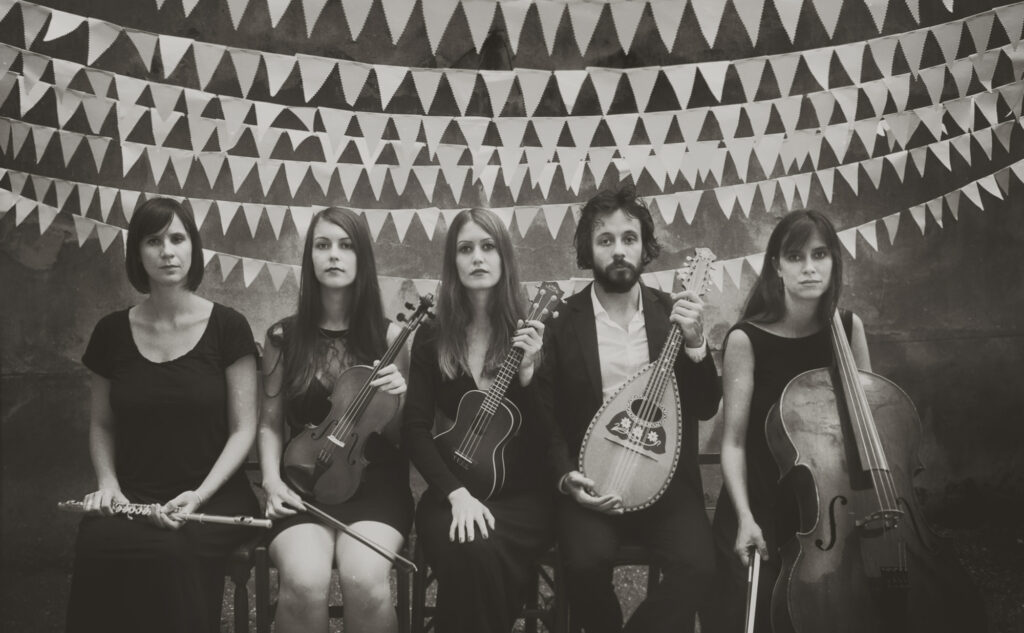
With Galaktoboureko, released in 2013, Ödland left behind the mists of Northern Europe and the industrial ruins to dive into a more sunlit and baroque world: that of the Eastern Mediterranean.
This new album marked an essential milestone in the group’s evolution: the affirmation of a warmer, more sensual music, open to broader horizons.
The record was directly inspired by the group’s stay in Greece, during which Lorenzo collected traditional instruments — bouzouki, baglama. Passionate about rebetiko music, he embarked on a meticulous work of listening, decoding, and reinterpreting this unique soundscape, rich with an orally transmitted popular memory.
Thus, Galaktoboureko expanded Ödland’s universe towards a mixed Mediterranean. The choice of the title — a Greek dessert of Turkish origin — was not random: it symbolized the marriage of cultures, bittersweet ambiguity, and fragile joy.
The album does not merely evoke the Mediterranean: it reinvents it. In Galaktoboureko (the song), the beloved body becomes a sweet dessert, a blend of sensuality and absurdity. In Ce soir je bois, the flight into drunkenness tries to forget life’s pains. Ménades et satyres unabashedly celebrates the pleasures of the body and the present, in an unleashed ancient freedom. Orphelin, a false nursery rhyme of emancipation, reaffirms the group’s philosophy: finding freedom outside of imposed lineages.
Un baiser dans la nuit returns to a more melancholic vein, with a farewell song to the fragile and fleeting sweetness of human loves. Gypsy combines black humor and cruel tenderness in the portrait of a jealous dog, a mirror of family torments.
In Le long du Bosphore, a nap lulled by the murmurs of Istanbul shifts into a hallucinatory dream where ancient cities blend together, merging into a cosmic reverie. Serait-ce un rêve ? closes the album on an existential question — dream or reality, memory or illusion?
Musically, Ödland integrates new Mediterranean instruments while preserving its acoustic DNA. The bouzouki, baglama, and banjoline add oriental colors, while Léa Bingöllü’s violin, the ukulele, and Alizée’s voice extend the inner emotion.
The group welcomed two new musicians: Mélodie Carecchio on flute and Lucie Lacour on cello. Their presence gave the pieces a more orchestral breadth, a shade of chamber music.
Three music videos visually illustrate this prolific period:
This album marks an apex in the complexity of arrangements and the diversity of forms. It carves out a unique furrow: that of a group that does not seek to “sound local” but rather to reinvent its own poetic territories from the living material of European cultures.
Between East and West, between scholarly and popular traditions, Ödland here seeks a music that avoids easy exoticism or frozen folklore — instead crafting a living, haunted writing. In this, Galaktoboureko stands as one of the richest and most unruly chapters in the group’s history.
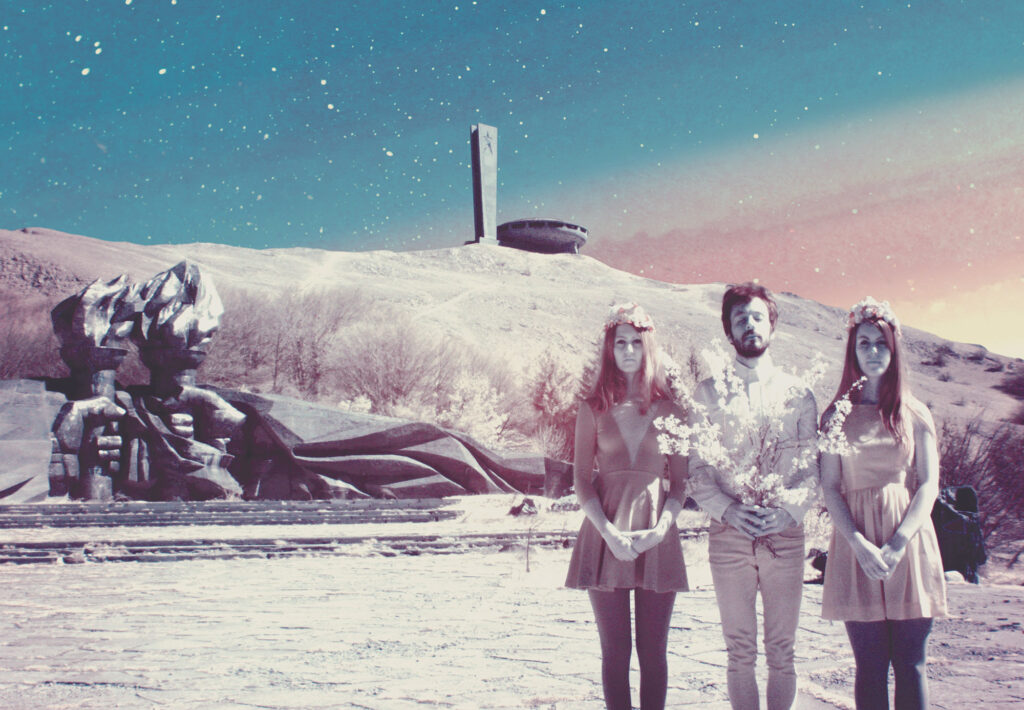
With Comète, released on December 13, 2015, Ödland takes to the skies. After mapping the legends and wounds of Europe through Sankta Lucia and Galaktoboureko, the group leaves solid ground to explore the outer edges of the sky, the void, and time itself.
This marks the beginning of a spatial and political cycle, where scientific imagery, fallen utopias, and electronic instruments are interwoven with the group’s traditional, artisanal approach to poetic songwriting.
This album is about collapse, vertigo, and cosmic disillusionment. Starting with Comète, the title track: born in the Oort cloud, a comet leaves its stellar suburb, blazes as it nears the Sun, and ultimately burns out completely. This astral destiny becomes a metaphor for human ideals that self-destruct through an excess of light.
Comète unfolds across 67 minutes, a lush weave of mixed influences: Eastern European folk music, fragments of hip-hop, contemporary classical echoes, cosmic ballads, and experimental sounds. Electronic instruments — analog synthesizers, drum machines — take on a new role without erasing the loyal acoustics of piano, violin, musical saw, cello, and flute. This fragile alliance between folk and science fiction is made possible by meticulous production work.
The mixing, handled by Mikrokosm Studio in Lyon, carefully balances the fragile texture of strings and woodwinds with the vaporous density of synthetic layers.
The album’s thematic gravity unfolds in every song. In Like Dinosaurs, the extinction of human love is compared to the extinction of species. The tone is both tender and fatalistic: « Like dinosaurs, we will disappear, » sings the voice, suspended between resignation and wonder.
In Après avoir décroché les étoiles (« After Having Reached the Stars »), Ödland questions the illusions of technical progress: after conquering the sky, humanity plummets, unable to sustain its own dreams.
The video clip, filmed atop Buzludzha in Bulgaria — a socialist ruin with a futuristic design — visually portrays this collapse. This monumental vestige of Soviet utopia becomes, in the film, a paper rocket ready to fall into the void. The infrared footage captures ghostly, glacial landscapes, while handmade stop-motion sequences crafted by Lorenzo Papace highlight the childlike fragility of our grand ambitions. Watch here
La floraison des bambous, a reworking of an older piece, becomes an ecological fable about patience, survival, and nature’s cunning in the face of predation. By offsetting their flowering over centuries, bamboo plants thwart the traps laid by predators.
In La neige fond (« The Snow Melts »), piano, theremin, flute, and cello weave a timeless sci-fi instrumental, subtly evoking the inexorable melting of the glaciers and the urgency of the global ecological crisis.
With À Kalachi, the group explores a mysterious real-world event: a village in Kazakhstan struck by an unexplained epidemic of deep sleep. The song transforms this mystery into a sleepwalking elegy, suspended between dream and hidden industrial catastrophe. The refrain — « À Kalachi, c’est toujours la nuit » (« In Kalachi, it is always night ») — repeats like a mantra of oblivion.
In Bambi, an orphaned and naive figure confronts the ruin of an industrial world. Beneath its lighthearted surface, the song becomes a brutal initiatory journey: a coming to consciousness in a landscape ravaged by humans. It is a modern, cruel parable, where innocence meets desolation, in a post-apocalyptic world where illusions have been shattered.
Avenue de la Nation Radieuse develops a critical and poetic vision of modernist urbanism, inspired by architectural utopias promoted by figures like Le Corbusier. The title explicitly references the « Ville Radieuse » (« Radiant City »), an emblematic project for a rationalized and hierarchical city. The song portrays a narrator wandering through a frozen, mineral, and impersonal urban landscape. The minimalist first-person writing style conveys a profound loss of bearings in this concrete world, a feeling of absurdity and alienation in the face of a modernity stripped of horizons.
The song was written by Lorenzo Papace during an artist residency in Minsk, Belarus, whose brutalist architecture profoundly marked him. During his stay, he methodically photographed the imposing, solemn geometric structures of this city, rebuilt after World War II according to Soviet canons. These images accompany the music video. The result is an audiovisual work where music, text, and photography dialogue to question the ruins of a modernist dream turned into architectural solitude. Watch here
Tu vois opens a brighter window into this dusky landscape. It’s a celebration of wonder and freedom, a call for lightness, improvisation, and the rediscovery of the simple magic of the living. The Golden Mountain, the first milestone of this cycle, was written for the Musée d’Orsay in 2014. Its animated clip, awarded at the Young Director Award in Cannes, confirms Ödland’s artisanal, meticulous, and poetic approach to visual storytelling. Watch here
Finally, Sloviansk Wedding Song focuses on the outbreak of war between Ukraine and Russia through the eyes of a bride. What was meant to be a celebration turns into a battlefield, a wedding bloodied by power struggles and violence.
Blending traditional song and contemporary outcry, this piece testifies to Ödland’s poetic engagement: speaking of the world without slogans — refusing to reduce the complexity of events to simplistic, binary messages. Far from didacticism, Ödland embraces fruitful ambiguity, embodied emotion, and the multiplicity of meanings.
This refusal of slogans is not a retreat: it is a more demanding way of bearing a political and sensitive gaze upon our time, leaving the listener with the responsibility of interpretation.
The album closes with Extinction, a brief and mournful piece: the final breath of a world disappearing into the silence of dead stars.
With Comète, Ödland reaches a new maturity. The album interweaves science and poetry, ruins and constellations, absurd humor and historical gravity. It explores collective memory, the fall of civilizations, the disillusionments of progress. It is a meditation on collapse — of stars, of ideals, of civilizations — but also a lucid and tender elegy for what fades away.
Between the fall of stars, the architectural vestiges of faded utopias, the vertigo of broken loves, and radioactive dreams, Ödland traces a unique furrow: that of a poetic ghost ship, navigating the mists of an uncertain age.
And above these ruined landscapes, some dead stars still shine.
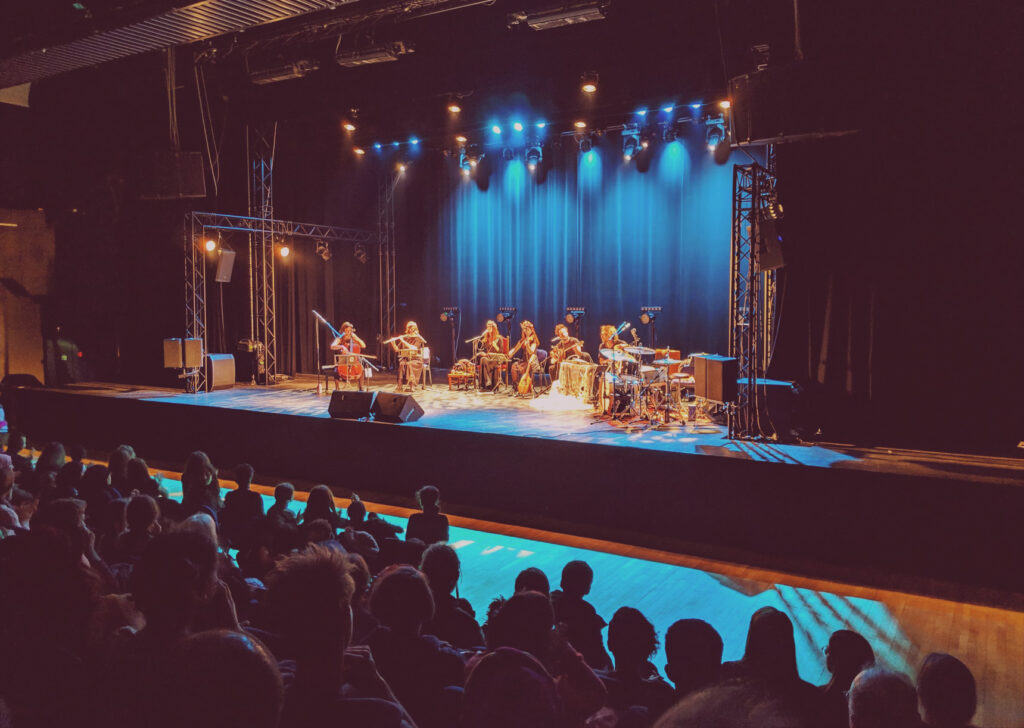
With the album Live at the Épicerie Moderne, released in 2019, Ödland returns to a direct and acoustic aesthetic, resonating with a vision of a possible world without electricity. This live album, recorded in a landmark venue in Lyon, marks the first time the group officially captures the ephemeral energy of their concerts.
Yet the stage has always been central to Ödland’s approach: from the very beginning, the group has played a living music, rooted in performance, breath, and presence. Even in the studio, recordings are often captured in a single take, with imperfections embraced as traces of sincerity. This strong bond between studio and stage explains the organic coherence of this live album with the rest of their body of work.
On stage, this concert brings together Lorenzo Papace (pianet, mandolin), Alizée Bingöllü (vocals, concertina, ukulele), Léa Bingöllü (violin, musical saw), Lucie Lacour (cello), Mélodie Carecchio (flute), and, for the first time, Sylvain Kaalau on percussion. The latter, encountered through the parallel project L’École du Chat Noir founded by Lorenzo and Mélodie in 2019, joined the Ödland universe, extending their musical complicity into a new scenic context.
This return to acoustics is accompanied by a deliberate technological austerity: no projections, minimal amplification, a sober stage setup inspired by the magic of theater. Here, the group chooses proximity, sharing, and clarity. They move away from the electronic sophistication of Comète to reconnect with their artisanal roots.
In this stripped-down environment, the instruments reclaim a central place. Piano, violin, cello, flute, percussion, and voices respond to one another in a chiaroscuro of sound.
The album does not seek spectacle but intimacy. It captures the warmth of a shared moment, a common breath. It also celebrates the loyalty of the audience: present, attentive, and complicit. An audience that, for more than a decade, has accompanied Ödland on its musical and poetic explorations.
The group plays as it is: an independent collective, faithful to its aesthetic, its freedom, and its poetry. A group that knows beauty sometimes arises from silence, from economy, from simplicity. And that in this very stripping away, a new depth can take root.
Among the songs performed during this concert, three form a triptych with strong libertarian and ecological resonances: Notre grand drapeau noir (« Our Great Black Flag »), Toi le flic (« You the Cop »), and Adieu (« Farewell »).
Notre grand drapeau noir is an epic and solidaristic song, where each verse addresses a different figure of exploitation or marginalization: the worker, the battered young girl, the immigrant, the child, the gay and lesbian individual, the rebellious ecologist. The refrain, both solemn and joyful, invites reclaiming a black flag of hope and insubordination.
Toi le flic delivers a virulent indictment against police authoritarianism, listing the police’s complicity with capitalist logics and social injustices. The text, ironic and uncompromising, denounces systemic brutality beyond individual actions.
Adieu is a bittersweet farewell ballad, addressed to a dying industrial civilization. The text, elliptical yet resolute, bids an unapologetic goodbye to shop windows, machines, and the illusions of endless growth. It carries the hope of a true revolution to come.
Other songs enrich the concert as well: Dublin City tells the story of a prisoner’s escape from the city, a symbol of individual liberation. Tout s’est effondré (« Everything Collapsed ») imagines a radical and joyful popular uprising, where the fall of old structures paves the way for a world without hierarchy or oppression.
La floraison des bambous, Orphelin, Ce soir je bois, and Sur les murs de ma chambre revisit the group’s cherished themes: attachment to nature, intimate melancholy, and dark narratives.
Through the warmth of the concert, carried by inspired arrangements, these songs become poetic manifestos for another possible world — drawn between lightness and defiance, melancholy and hope.
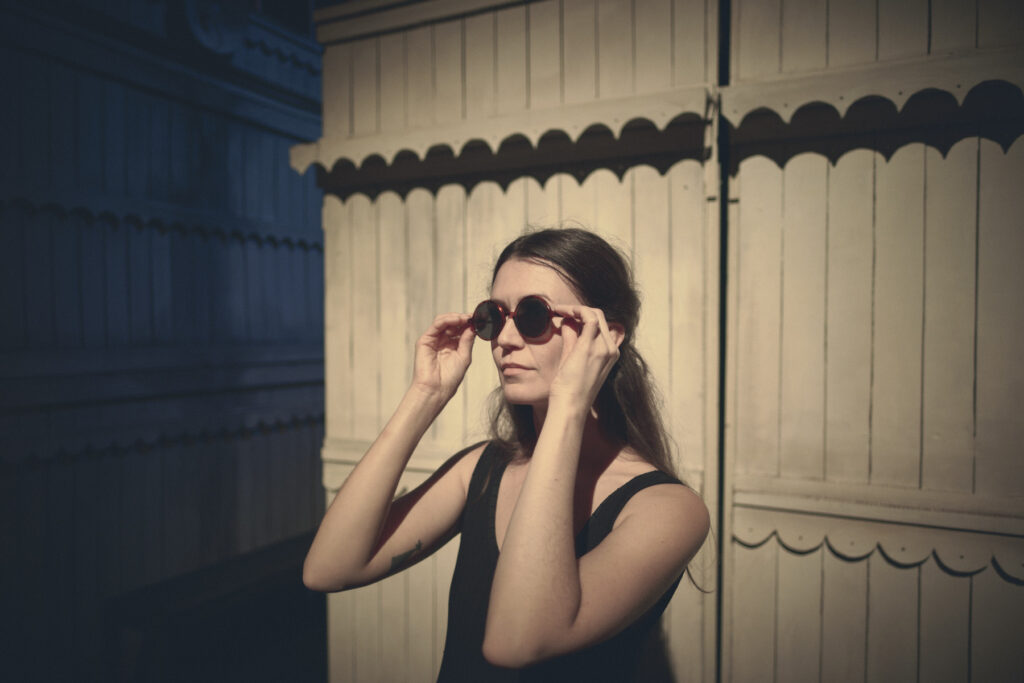
With Des vagues (2024), Ödland opens a new, ambitious, and intense era. For the first time, the group moves beyond weaving isolated songs: they invent a complete dramaturgy, writing and composing a true poetic, radical, and haunted musical.
Des vagues becomes a theater of reminiscences, of intimate ruins, of emotional shipwrecks — a plunge into the deepest layers of collective and personal memory.
The play is the fruit of a long and organic collaboration between Lorenzo Papace and Alizée Bingöllü. Alizée, author of the text, director, and singer of the group, infused it with her memories, her angers, her visions, her political sensitivity, and her experience as a mother.
Lorenzo composed the music and handcrafted the sets using paper, cardboard, and salvaged materials, creating an ephemeral theater with the aura of a ruined dream. Alongside them, Léa Bingöllü (violin) and several talented actors embody this oneiric odyssey with raw intensity.
Des vagues tells the story of a ship adrift at sea, inhabited by deranged characters, carried by winds, memory, and gentle madness — until the songs, like shattered mirrors, gradually reveal them, disclosing fragments of their lost stories.
The music — acoustic, modal, dramatic, and melancholic — follows the ship’s movements: pitching, rupture, apnea, illumination, shipwreck. Lorenzo’s oceanic piano conjures unstable, shifting emotional climates, infiltrated by cries, irony, and tenderness. Léa’s violin draws a fragile and sharp counterpoint, like shards of a past returning to disfigure the present.
Songs such as Albertine se souvient, Des flammes, and L’immense cosmos deconstruct intimate memory, explore familial cracks, and the erosion of human ties — through a language that is precise, brutal, and poetic. Alizée’s text navigates between lucidity and dream.
The play depicts a world unraveling — ecologically, politically, emotionally. It evokes the defense of life as an act of resistance in a collapsing world, patriarchal violence as the nucleus of collective shipwrecks, and art as a fragile gesture of survival against disintegration.
But Des vagues is not a work of thesis. Far from manifestos, it cultivates radical ambivalence. Grotesque meets grace, humor blooms within tragedy, violence erupts where one might expect solace. This tonal freedom is its most subversive strength: the refusal of simplification, the refusal to fix meaning.
The handcrafted scenography fully embraces its roots: mobile sets made of hand-painted cardboard, deliberately simple costumes, lighting reminiscent of old oil lamps. Each performance becomes a fragile ceremony, a fleeting and heartbreaking ritual.

In parallel with the show, Ödland released an EP titled Le bateau blanc, composed of three tracks: Le bateau blanc, Coup de vent, and Les landes oubliées. This EP extends the world of the play without being a literal continuation: it acts more like an echo, a parallel drift.
Le bateau blanc serves as a floating allegory: a maritime huis clos where memory, identity, and time gradually collapse. Inspired by a fictional letter found on a Norwegian beach, the song describes a haunted ship adrift on the ocean, its passengers seemingly oblivious to their destination.
The text, oscillating between diary and hallucination, is carried by spectral and unstable music, with altered harmonies suggesting a slow slide into oblivion. The song evokes the cycles of memory, devoured by doubt, and the sea as a vast graveyard of dreams.
Coup de vent, directly extracted from Des vagues, is a striking dramatic piece. In two minutes of intensity, it narrates the sudden disappearance of Anissa, thrown overboard during a violent storm. The rolling surge of the piano, the jolting violin, and the sonic gusts erase moments of calm, constructing a vivid scene of violence and vanishing.
Les landes oubliées synthesizes Ödland’s entire universe: imaginary folklore, cosmic horror, and crumbling memory. The song tells the story of discovering a deformed path leading to a cursed land absent from all maps: the desert of Ödland. Disfigured landscapes, obscure rites, and forgotten ruins weave a nightmare mythology.
The song shifts halfway through into a hallucinatory crescendo: breaths, phantom trains, entwined languages (English, French), and distant voices compose a dizzying auditory vertigo. The refrain “There is a land near Östersund” murmurs the existence of a real and spectral Ödland, somewhere between Scandinavia and the frayed edges of European memory.
Each track reinforces the group’s artisanal and dramatic aesthetic: raw acoustics, distorted scenarios, chipped beauty, and meticulous attention to sonic and visual detail.
With Des vagues and Le bateau blanc, Ödland reaches a peak of aesthetic, political, and narrative coherence. The group fully unfolds its art of ambiguity, its mastery of fragmentary storytelling, and its love for simple, weathered, haunted forms.
True to their poetic vocation, Ödland conjures in this ensemble the sea, memory, gentle madness, the erosion of civilizations, and a stubborn hope — like a fragile song for a world slowly fading beneath the waves.
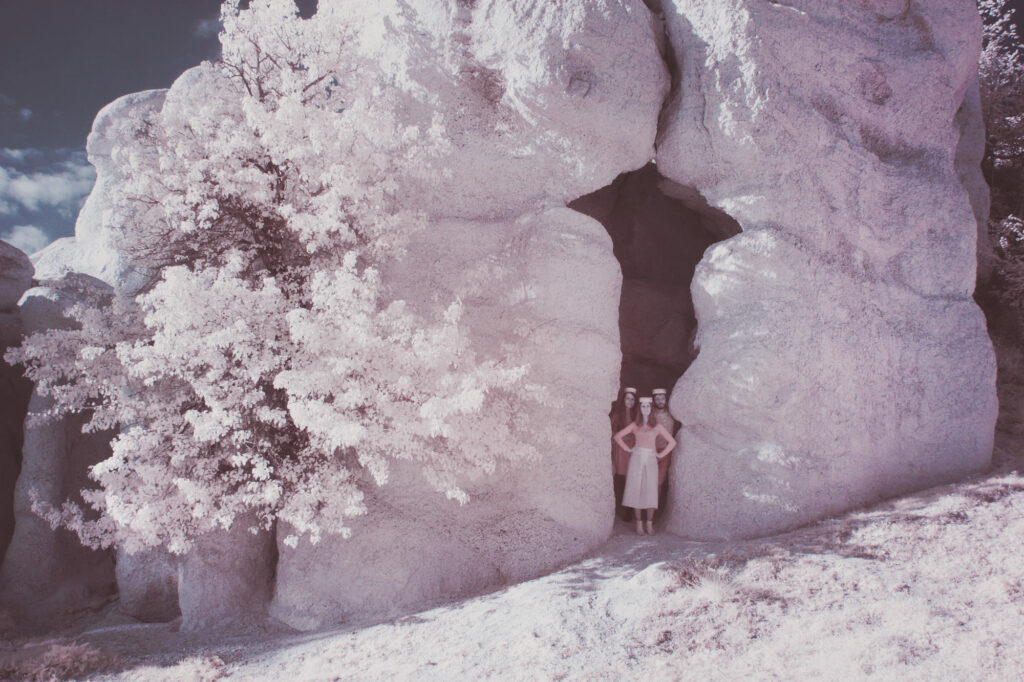
Since 2008, Ödland has been tracing a path against the dominant currents.
In a world saturated with noise, disposable images, and manufactured vertigo, their slow, demanding, and artisanal approach stands as a discreet form of poetic resistance. It is not a nostalgic retreat, but a way of inhabiting the world differently: by reinventing time, matter, and memory.
This path — winding, haunted, luminous — connects songs the way forgotten islands, scattered tales, and miniature worlds almost erased by the wind are linked. It meanders through the ruins of utopias, the legends of Europe, industrial disasters, beloved faces, and buried dreams.
Each album, each concert, each video, each fragment becomes a beacon lit in the night, a dead star that still shines.
Ödland has never submitted to the rhythms of the industry nor the fleeting seasons of fashion. Their project is a patient construction, a free work, woven from music, theater, fragmented narratives, handcrafted gestures, and stubborn visions.
What they offer is a parallel world — fragile, coherent, stretched between collapse and hope, inhabited by mourning, wonders, and absurdity.
For them, tracing a path is taking the risk of getting lost in order to invent anew. To venture without a map, guided only by the intermittent glow of certain secret lights. It means accepting that the path may lead nowhere — except perhaps to a little more clarity within the dark.
In the winding labyrinth of this abundant work, something remains obstinately:
And as long as there is a piano drifting on the tide, a violin cutting through the night, and a chorus murmuring among the ruins, Ödland will continue its journey — between the waves, the stardust, and the forgotten lands.
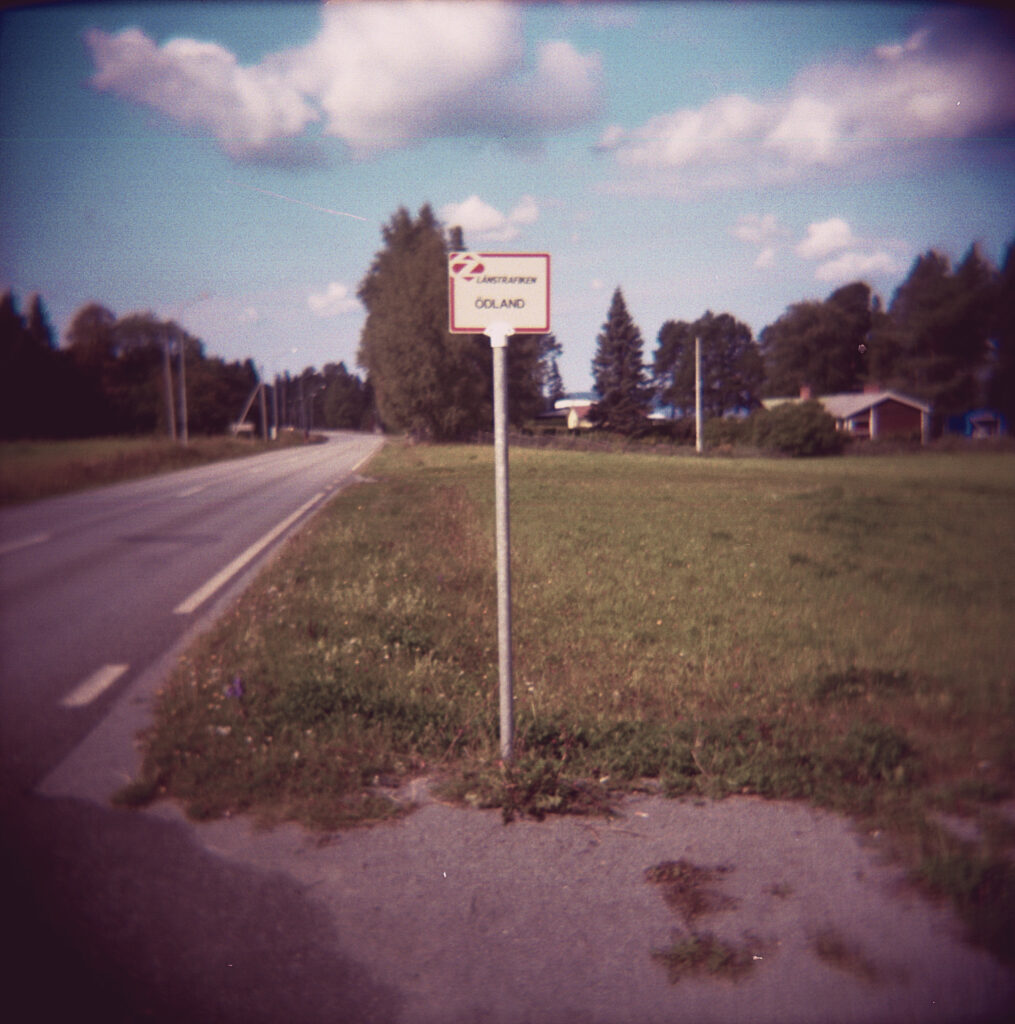
INSTRUMENTS | YEARS ACTIVE | |
Lorenzo Papace | Piano, synthesizers, organ, drum machines, mandola, bouzouki, banjoline. | 2008-présent |
Isabelle Royet-Journoud | Ukulele, melodica, toys, tambourine | 2008-2012 |
Alizée Bingöllü | Vocals, ukulele, toys, tambourine, concertina, baglama | 2008-present |
Léa Bingöllü | Violin, musical saw, theremin | 2008-present |
Alice Tahon | Cello | 2009-2010 |
Mélodie Carecchio | Flute | 2012-present |
Lucie Lacour | Cello | 2012-present |
Sylvain Kaalau | Percussion | 2019-present |
15.05.2025 SAINT-FONS (France) Église Notre-Dame du Rosaire
21.03.2025 VÉNISSIEUX (France) Théâtre de Vénissieux
08.03.2025 FEYZIN (France) Théâtre Le Rex
04.03.2025 FEYZIN (France) Kiosque «Des vaguelettes »
23.01.2025 AURILLAC (France) Théâtre d’Aurillac «Des vagues »
17.01.2025 PORTE-LES-VALENCE (France) Train Théâtre «Des vagues »
15.12.2024 CORBAS (France) Polaris «Des vagues »
16.11.2024 CALUIRE (France) Radiant Bellevue, 1ere partie de Dionysos
08.11.2024 CORBAS (France) Polaris «Des vaguelettes »
08.10.2020 CHAMBÉRY (France) Brin de Zinc
09.05.2019 FEYZIN.(France) Épicerie moderne
18.03.2017 ZUTPHEN.(Netherlands) Luxor Theater
05.03.2016 LYON.(France) NTH8 Nouveau Théâtre du Huitième, Soirée Comète
21.01.2016 ROVERETO.(Italie) Musée d’art moderne et contemporain
29.06.2015 FEYZIN.(France) L’épicerie moderne, concert en jardin
18.04.2015 FONTENAY-SOUS-BOIS.(France) Espace Gérard Philippe
08.04.2015 LYON.(France) Le Transbordeur, tremplin Les inRocKs
15.10.2014 PARIS. La Belleviloise
17.05.2014 RILLEUX-LA-PAPE.(France) Espace Baudelaire
09.11.2013 LYON.(France) Boutique Harmonia Mundi
09.11.2013 LYON.(France) Bibliothèque de la Part-Dieu
21.10.2013 KARLSRUHE.(Germany) Private show
20.10.2013 KÖLN.(Germany) Kulturcafe Lichtung
19.10.2013 UNNA.(Germany) Spatz un Wal
18.10.2013 DUISBURG.(Germany) Grammatikoff
17.10.2013 MÜNSTER.(Germany) Picasso Museum
16.10.2013 WALDSHUT-TIENGEN.(Germany) Stellwerk
15.10.2013 ZÜRICH.(Switzerland) Café Henrici
14.10.2013 WINTERTHUR.(Switzerland) Portier
12.10.2013 FÜRTH.(Germany) Badstraße 8
11.10.2013 LEIPZIG.(Germany) Noch besser Leben
10.10.2013 HANNOVER.(Germany) Feinkost Lampe
05.07.2013 LYON.(France) Festival MUZZ, Place du 8 mai 1945
02.11.2012 LYON.(France) Transbordeur. 1ere partie de Dionysos
25.05.2012 BOCHUM.(Germany) Rottstr 5
26.05.2012 KÖLN.(Germany) Kulturcafé Lichtung
29.05.2012 HAMBURG.(Germany) Astra Stube
30.05.2012 MÜNSTER.(Germany) SpecOps
31.05.2012 HANNOVER.(Germany) Feinkost Lampe
01.06.2012 WERNE.(Germany) Flöz-K
02.06.2012 LEIPZIG.(Germany) Noch Besser Leben
03.06.2012 BERLIN.(Germany) Badehaus
05.06.2012 MAGDEBURG.(Germany) Moritzhof
06.06.2012 WUPPERTAL.(Germany) Bürgerbahnhof Vohwinkel
07.06.2012 UNNA. (Germany) Spatz und Wal
08.06.2012 DÜSSELDORF.(Germany) Damen Und Herren
09.06.2012 STUTTGART.(Germany) Café Galao
12.03.2012 DUISBURG.(Germany) Duisburger Akzente
13.03.2012 ZÜRICH(Switzerland) Henrici Kaffee Concert
11.11.2011 LYON.(France) NTH8. Nouveau Théâtre du Huitième. Sortie Sankta Lucia
12.12.2010 LYON.(France) Boutique de chaussure Heschung
20.11.2010 LYON.(France) Concert privé chez P&P
26.07.2010 PARIS.(France) L’International
24.07.2010 ERFURT.(Germany) 7a-versenkt Gallery
23.07.2010 DUISBURG.(Germany) Steinbruch
22.07.2010 UNNA.(Germany) Spatz und Wal
11.07.2010 SHEFFIELD.(United Kingdom) The Rude Shipyard
10.07.2010 MANCHESTER.(United Kingdom) Nexus Art Cafe
09.07.2010 LIVERPOOL.(United Kingdom) View Two Gallery 1ere partie Stealing Sheep
08.07.2010 LONDON.(United Kingdom) The Betsey Trotwood
15.04.2010 LYON.(France) Hot Club Jazz. Sortie Ottocento
08.03.2010 LYON.(France) Nouveau Théâtre du Huitième
23.10.2009 LYON.(France) Le Sonic
20.06.2009 RILLEUX-LA-PAPE.(France) Médiathèque
13.06.2009 LYON.(France) Hot Club Jazz
16.05.2009 LYON.(France) La Marquise. 1ère partie de Céleste
Ne manquez pas nos
concerts
Inscrivez-vous à notre Newsletter
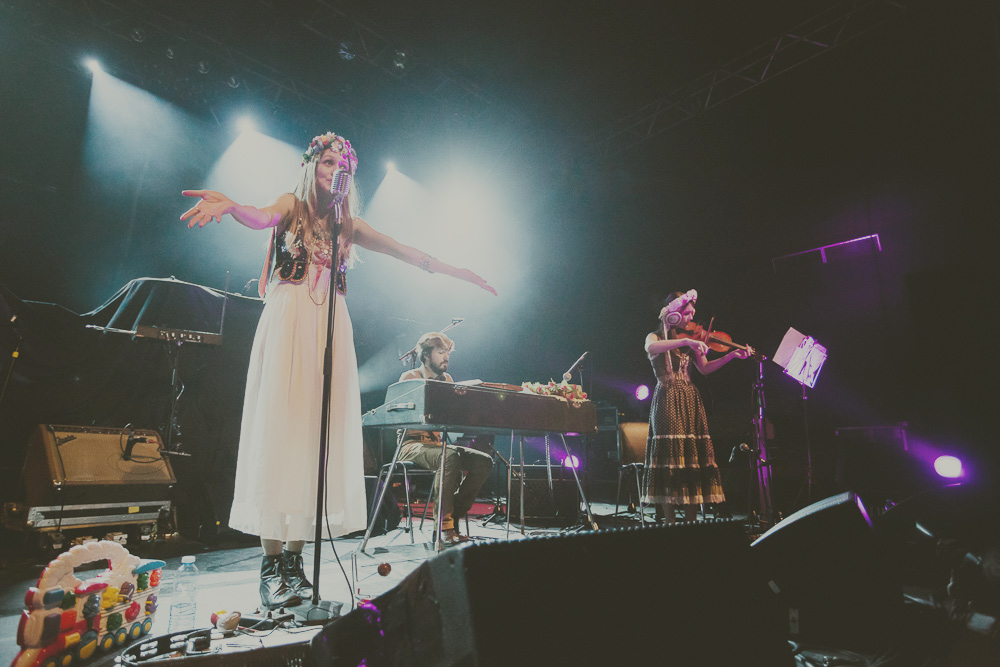
Chers amis, pour nous contacter, veuillez utiliser le formulaire ou notre adresse ci-dessous. Nous vous répondrons dans les meilleurs délais.
odland@odland.fr